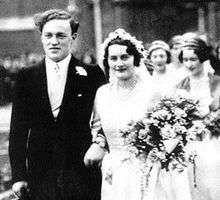Elizabeth Pakenham, Countess of Longford

Elizabeth Pakenham, Countess of Longford, CBE (30 August 1906 – 23 October 2002), better known as Elizabeth Longford, was a British historian. She was a member of the Royal Society of Literature and was on the board of trustees of the National Portrait Gallery in London. She is best known as a historian, especially for her biographies of 19th-century luminaries such as Queen Victoria (1964), Lord Byron (1976) and the Duke of Wellington (2 vol 1969).
Life
Born Elizabeth Harman and a daughter of eye specialist Nathaniel Bishop Harman, she was educated at the Francis Holland School, and was an undergraduate at Lady Margaret Hall, Oxford. "Able, articulate and beautiful", in the words of The New York Times, she was "the Zuleika Dobson of her day, with undergraduates and even dons tumbling over one another to fall in love with her".[1] A few years after her graduation, on 3 November 1931, she married Frank Pakenham, later 7th Earl of Longford, who died in August 2001. Her obituary by the BBC said the marriage was "famously harmonious." The New York Times, in its review of The Pebbled Shore, called Lady Longford "easily the best writer in what is predominantly a literary family".[1]
She and her husband were both devout Roman Catholic converts, Lady Longford having been raised a Unitarian, and avid social reformers. The Longfords had eight children, among them the writers Lady Antonia Fraser, Lady Rachel Billington, Judith Kazantzis, and Thomas Pakenham.
She lived to the age of 96, dying in October 2002, 14 months after her husband. Lord Longford and his wife Elizabeth would have celebrated their 70th wedding anniversary on 3 November after a marriage that produced four sons and four daughters, followed by 26 grandchildren and 18 great-grandchildren.[2]
Political career
She made several unsuccessful attempts to win election to the House of Commons as a Labour MP. In 1935 she contested Cheltenham, which was a safely-Conservative seat, and in 1950 she was defeated by Quintin Hogg at Oxford. Through the war she had sought selection at Birmingham King's Norton until she felt compelled to cease her candidacy upon her sixth pregnancy in 1944; the seat was a Labour gain in 1945 by 12,000 votes.[3]
Family
Her brother, John B. Harman, was a doctor. Lady Longford was a great-niece of the Tory radical Joseph Chamberlain and a first cousin once removed of the British prime minister Neville Chamberlain.[1]
Bibliography
- A Pilgrimage of Passion: The Life of Wilfrid Scawen Blunt (I.B. Tauris, re-issued 2007)
- Victoria R.I. (1964) Published by Weidenfeld and Nicolson and awarded the James Tait Black Memorial Prize ISBN 0-297-84142-4
- Byron (1976) Published by Hutchinson of London & Weidenfeld and Nicolson ISBN 0-09-127300-5
- Eminent Victorian Women (1981)
- Royal Throne: The Future of the Monarchy (1993)
- The Royal House of Windsor Published by Alfred A. Knopf New York (1974)
- The Pebbled Shore (1986) Biography.
- Jameson's Raid
- Wellington: The Years of the Sword and Wellington: Pillar Of The State, a two-volume biography of the first Duke of Wellington, who numbered among her husband's relatives.
- Winston Churchill
- Elizabeth R: A Biography
Footnotes
- 1 2 3 Howard, Anthony (26 October 1986). "A Life Of Her Own". The New York Times. Retrieved 1 May 2010.
- ↑ Bradford, Sarah (24 October 2002). "The Countess of Longford". The Independent. London: Independent News & Media. Retrieved 2008-10-22.
- ↑ Grove, Valerie (24 October 2002). "Lady Elizabeth Longford". The Guardian. London: Guardian News & Media. Retrieved 2008-10-22.